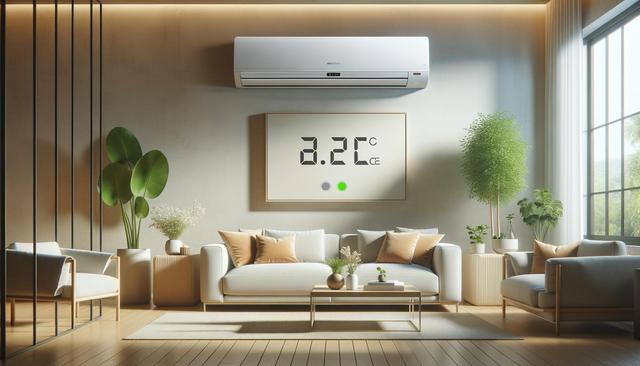Finding the Right Temperature Setting for Your Air Conditioner
Set your air conditioner between 24°C to 26°C (75°F to 78°F) for optimal comfort and energy efficiency. This range balances indoor cooling with reduced electricity usage, helping you stay cool without inflating your energy bills.

Why Temperature Settings Matter
The temperature setting on your air conditioner does more than just cool your home. It directly impacts your energy consumption, comfort, and utility costs. A setting that’s too low may cool the room quickly but will also put additional strain on the system and increase your energy usage. Conversely, a higher setting may not provide enough relief during peak summer heat. This is why experts recommend maintaining your air conditioner between 24°C and 26°C (75°F to 78°F) for a practical balance.
This temperature range is considered ideal because:
- It supports the body’s natural cooling process without overcompensating.
- Reduces the workload on your air conditioning unit.
- Helps to maintain indoor air quality and humidity levels.
- Minimizes electricity consumption, lowering your utility bills.
Choosing the correct setting can also extend the life of your system. When your unit doesn’t have to cycle too frequently or run at maximum output constantly, it experiences less wear and tear, potentially reducing maintenance costs over time.
Energy Efficiency and Cost Savings
One of the primary reasons for adjusting your AC temperature wisely is to save energy. Air conditioners use a large amount of electricity to maintain lower temperatures, and for every degree you lower the thermostat, energy usage can increase by about 6% to 8%. By setting your thermostat to a moderate range, you can significantly reduce your energy consumption without sacrificing too much comfort.
Here are a few energy-saving tips to pair with your AC settings:
- Use ceiling fans to help circulate air more effectively.
- Close curtains or blinds during the hottest part of the day.
- Ensure your space is well-insulated to prevent cool air from escaping.
- Schedule regular maintenance checks for your AC unit.
These steps complement the 24°C to 26°C range, allowing you to maintain a cool and comfortable environment while being mindful of energy use. Over time, these small adjustments can add up to noticeable savings on your electricity bills.
Adjusting for Different Needs and Room Types
While the recommended range works well for most households, individual preferences and room usage can influence your ideal setting. For instance, bedrooms may benefit from slightly cooler temperatures at night for better sleep, while living areas can be kept a bit warmer when not in use.
Consider the following when adjusting your temperature settings:
- Activity level: Spaces with higher activity may need cooler air to offset body heat.
- Occupancy: Rooms that are often empty don’t need to be cooled as aggressively.
- Time of day: You can increase the temperature slightly during the day when you’re not home and lower it in the evening when you’re back.
Using programmable thermostats or smart AC controllers can help automate these changes, ensuring comfort when needed and energy savings when possible. These tools allow for more precise control and can adapt to your schedule and habits over time.
Health and Comfort Considerations
Maintaining the right indoor temperature is also crucial for your health and comfort. Extreme cold settings can cause respiratory problems, dry skin, and discomfort, especially for children and older adults. On the other hand, inadequate cooling may lead to heat-related fatigue or sleep disturbances during warmer months.
Keeping the temperature in the recommended range supports:
- Better sleep quality by preventing the room from becoming too cold or too warm.
- Reduced chances of dehydration and dry nasal passages caused by overcooling.
- More stable indoor humidity levels, which can help prevent mold and dust mites.
It’s also helpful to dress appropriately for the season indoors. Lightweight and breathable clothing can increase your comfort even if the thermostat is set a bit higher. This way, you can remain comfortable without needing to lower the temperature unnecessarily.
Making the Most of Your AC Settings
To get the most from your air conditioning system, it’s important to combine the right temperature setting with smart usage habits. This includes ensuring your system is functioning efficiently and that your home is optimized for cooling. A well-maintained system can operate more effectively at a moderate temperature setting, offering both comfort and savings.
Here are a few ways to enhance your AC performance:
- Replace or clean air filters regularly to improve airflow.
- Seal windows and doors to prevent cool air leakage.
- Use zoning systems if available, to cool only the areas you use.
- Install a programmable thermostat to automate energy-saving schedules.
By combining these practices with a temperature setting in the 24°C to 26°C range, you can create a comfortable indoor environment that’s also energy-efficient. These strategies not only help you manage your monthly energy costs but also contribute to a more sustainable household energy footprint.
Conclusion: Set Smart, Stay Comfortable
Finding the right temperature setting for your air conditioner isn’t just about comfort—it’s about making smart choices that benefit your wallet, your health, and the environment. By keeping your thermostat between 24°C and 26°C, and pairing it with good habits and smart tools, you can enjoy a cooler home without unnecessary energy waste. Whether you’re looking to improve your sleep, cut down on utility costs, or reduce your carbon footprint, thoughtful temperature management is a simple yet effective step in the right direction.